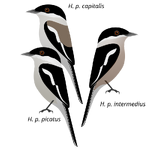| Seriemas | |
|---|---|
| File:Cariama cristata.png | |
| Cariama cristata | |
| Scientific classification | |
| Kingdom: | Animalia |
| Phylum: | Chordata |
| Class: | Aves |
| Clade: | Inopinaves |
| Superfamily: | Cariamoidea |
| Family: | Cariamidae Bonaparte, 1853 |
| Genera and species | |
The seriemas are the sole extant members of the small and ancient family Cariamidae, which is also the sole surviving family of the Cariamae. Once believed to be related to cranes, they have been placed by one recent study near the falcons, parrots and passerines.[1] There are two species:
- Red-legged Seriema, or Crested Cariama, Cariama cristata. This is found from eastern Brazil, to central Argentina. It is bigger and nests on the ground or in a bush or tree up to 3 m (9.8 ft) above the ground.
- Black-legged Seriema, Chunga burmeisteri. This is found in northwest Argentina and Paraguay. It nests in a tree.
Description
Ranges of Red-legged (green) and Black-legged (blue) seriemas.
Both species are around 80 cm (31 in) long; the Red-legged Seriema is slightly bigger than the Black-legged. They forage on foot and run from danger rather than fly (though they can fly for short distances, and they roost in trees). They have long legs, necks, and tails, but only short wings, reflecting their way of life. They are brownish birds with short bills and erectile crests, found on fairly dry open country, the Red-legged Seriema preferring grasslands and the Black-legged Seriema preferring scrub and open woodland.
They give loud, yelping calls and are often heard before they are seen.
Diet
Ecologically they are the South American counterpart of the Secretary Bird. They feed on insects, snakes, lizards, frogs, young birds, and rodents, with small amounts of plant food (including maize and beans). They often associate with grazing livestock, probably to take insects the animals disturb. When seriemas catch small reptiles, they beat the prey on the ground (Redford and Peters 1986) or throw it at a hard surface to break resistance and also the bones. If the prey is too large to swallow whole, it will be ripped into smaller pieces with a sickle claw (pictured below) reminiscent of those in deinonychosaurs like Velociraptor and Troodon by holding the prey in the beak and tearing it apart with the claw.
Reproduction
Seriemas build bulky stick nests. They lay two or three white or buff eggs sparsely spotted with brown and purple. The female does most of the incubation, which last from 24 to 30 days. Hatchlings are downy but stay in the nest for about two weeks; then they jump down and follow both parents. They reach full maturity at the age of four to five months.
Relationship with humans
People sometimes capture young seriemas and tame them, keeping them with poultry to ward off predators.
Prehistoric relatives

Idiornis tuberculata fossil
The two extant species of seriema are thought to be the closest living relatives of a group of gigantic (up to (up to 10 ft/3.0 m tall) tall) carnivorous "terror birds", the phorusrhacids, which are known from fossils from South and North America.[2][3] Several other related groups, such as the idiornithids and bathornithids were part of Palaeogene faunas in North America and Europe and possibly elsewhere too.[2][3] However, the fossil record of the seriemas themselves is not good, with a single prehistoric species (Chunga incerta) having been described to date. Some of the fossils from the Eocene fauna of the Messel Pit (i.e. Salimia and Idiornis) have also been suggested to be seriemas,[4] though their status remains uncertain.
The seriemas have an extensible second claw that is raised from the ground. This resembles the "sickle claw" of Velociraptor and its relatives.
Etymology
Names for these birds in the Tupian languages are siriema, sariama, çariama, which are explained as meaning "crested" (New Shorter Oxford English Dictionary).
References
- ^ Hackett, Shannon J.; et al. (2008-06-27). "A Phylogenomic Study of Birds Reveals Their Evolutionary History". Science. 320 (5884): 1763–1768. PMID 18583609. doi:10.1126/science.1157704. Retrieved 2008-10-18. Cite uses deprecated parameter
|coauthors=(help) - ^ a b Naish, Darren (2006-10-27). "Terror birds". Darren Naish: Tetrapod Zoology. Retrieved 2008-03-29.
- ^ a b Alvarenga, H. M. F.; Höfling, E. (2003). "Systematic Revision of the Phorusrhacidae (Aves: Ralliformes)" (PDF). Papéis Avulsos de Zoologia. São Paulo: Museu de Zoologia da Universidade de São Paulo. 43 (4): 55–91. doi:10.1590/S0031-10492003000400001. ISSN 0031-1049. Retrieved 2008-03-29. Cite uses deprecated parameter
|coauthors=(help); External link in|publisher=(help) - ^ Morlo, M & al. (2004): An annotated taxonomic list of the Middle Eocene (MP 11) Vertebrata of Messel. Courier Forschingsinstitut Senckenberg 252, pp 95-108. [1]
- Holyoak, David; Heinsohn, Robert (2003). "Seriemas". In Christopher Perrins (Ed.). Firefly Encyclopedia of Birds. Firefly Books. p. 222. ISBN 1-55297-777-3. Cite uses deprecated parameter
|coauthors=(help)
- Redford, Kent H.; Peters, Gustav. "Notes on the biology and song of the Red-legged Seriema (Cariama cristata)" (pdf). Journal of Field Ornithology. 57 (4): 261–269. Retrieved 2007-07-30. Cite uses deprecated parameter
|coauthors=(help)
Pictures
External links
- Seriema videos on the Internet Bird Collection
| Wikimedia Commons has media related to: http://commons.wikimedia.org/wiki/Cariama_cristata |

|
This article is part of Project Bird Taxonomy, a All Birds project that aims to write comprehensive articles on every order, family and other taxonomic rank related to birds. |
| This page uses Creative Commons Licensed content from Wikipedia (view authors). Please help by writing it in the style of All Birds Wiki! |



